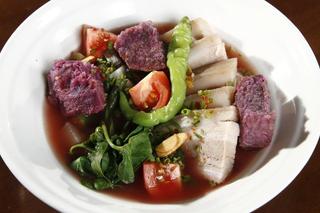7 Innovative Sinigang Ingredients to Try at Home

Who doesn’t enjoy a steaming hot bowl of sinigang? The sour soup is a source of comfort for Filipinos of all ages. This ulam is also a go-to when you need to whip up something quick and effortless (budget-friendly, too!) for the family. Just combine all your sinigang ingredients in a pot, pick a protein, add a souring agent, and let everything simmer to perfection. Done!
Like in most Pinoy households, you likely grew up accustomed to a specific way of preparing the dish. Do you also judge others if they cook a version that doesn’t match your preferred level of asim, lapot, and linamnam? Others even push aside their bowl if they see an unfamiliar veggie added to their soup. But the times are a-changing! As Filipino cuisine evolves, traditional dishes also receive modern tweaks from creative minds.
7 Sinigang Ingredients Inspired by Top Restaurants
Gone are those days when sampalok was the only ingredient you could use for your recipe. These days, professional cooks include ube, watermelon, and kimchi in their list of pork sinigang ingredients. It’s high time you followed suit and gave your fave ulam a much-needed revamp. Take inspiration from these variations innovated by some of Manila’s top restaurants. Have fun!
1. Watermelon
Combining sweet and sour flavors in a dish is not a novel idea. But adding fruits to your sinigang is something you probably never tried before. Pinoy restaurant Manam banked on this idea to come up with their sinigang sa watermelon. Recreate this bestseller by souring your soup with Knorr Sinigang Mix and tossing in fresh watermelon cubes towards the end. Complete the experience by also using beef short ribs as your main protein. Enjoy sinigang sa watermelon while hot and serve with mounds of white rice and a saucer of spicy patis.
2. Mango and guyabano
Mango and guyabano is a pairing many would associate with smoothies. But did you know this power combo works just as well as sinigang na bangusingredients? Concocted by Bench Café, this version is the perfect mix of sweet and tangy. To make, follow this easy sinigang sa mangga recipe and add shredded ripe soursop into the mix. Enjoy!
3. Kimchi
If you’re a fan of Korean kimchi, you’ll fall in love with Locavore’s reimagination of sinigang. Effortlessly remake this dish by combining classic pork sinigangingredients, kimchi, tofu, and arugula. If you’re skipping meat, you can also try this with shrimp. But the most crucial step here is sourcing good-quality kimchi. Visit your nearest Korean grocery for the best kind!
4. Chorizo
Introduce a robust spicy taste with hints of sweetness by “spiking” your corned beef sinigang with chorizo rounds. This version by Café Juanita is not for the traditionalists. It’s an absolute umami bomb in every spoonful! To recreate it at home, follow your usual recipe but use your favorite canned corned beef and add as much chorizo as your heart desires.
5. Guava and pineapple
Are you looking to jazz up your usual sinigang na baboy recipe? Try Mesa’s spin on the classic by adding guava and pineapple. Enjoy the creamy texture the bayabas lends the dish and bask in the vibrant flavors from the pineapple. Just grab a can or cut open some fresh fruit and mix in sweet-tangy chunks into the base. The smell alone will make mouths water!
6. Ube
Ube is globally known as a dessert ingredient added to cakes, ice cream, cookies, and pastries. But a few years back, the yams debuted in Abe’s bowl of sinigang. The purple chunks offer subtle sweetness and help thicken the soup base. Plus, it introduces a lively hue to the dish that can entice even the pickiest eaters. Try it as a replacement for gabi next time you cook the dish.
7. Kurobuta pork
Anyone who’s tried Mamou’s kurobuta sinigang has nothing but praise for the dish. At first glance, it looks just like your ordinary soup. However, one bite reveals succulent meat with incomparable juiciness. Kurobuta, or black hog in Japanese, is a type of pork prized for its ultra-tender texture and intricate marbling. Source it next time you have VIPs over and want to surprise them with the most unforgettable sinigang they will taste.
Now is your chance to give your tired recipe an instant glow-up. Cull inspiration from these innovative restaurant versions featuring unique sinigangingredients. Try out each reimagination and find a new favorite!
Suggested Article

Japanese Natto: A Quick Guide
